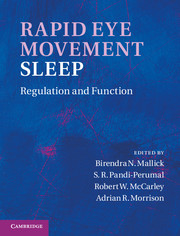Book contents
- Frontmatter
- Contents
- Contributors
- Preface
- Acknowledgments
- Organization
- Section I Historical context
- Section II General biology
- Section III Neuronal regulation
- Section IV Neuroanatomy and neurochemistry
- 19 Aminergic influences in the regulation of basic REM sleep processes
- 20 REM sleep regulation by cholinergic neurons: highlights from 1999 to 2009
- 21 GABAergic modulation of REM sleep
- 22 Glutamatergic regulation of REM sleep
- 23 The role of tuberomammillary nucleus histaminergic neurons, and of their receptors, in the regulation of sleep and waking
- 24 Hypocretinergic system: role in REM-sleep regulation
- 25 Neuropeptides and REM sleep
- 26 Adenosine and glycine in REM-sleep regulation
- 27 Changes in neurotransmitter levels in relation to REM sleep for its regulation
- 28 Pontine areas inhibiting REM sleep
- 29 Neuronal models of REM-sleep control: evolving concepts
- Section V Functional significance
- Section VI Disturbance in the REM sleep-generating mechanism
- Index
- Plate section
- References
27 - Changes in neurotransmitter levels in relation to REM sleep for its regulation
from Section IV - Neuroanatomy and neurochemistry
Published online by Cambridge University Press: 07 September 2011
- Frontmatter
- Contents
- Contributors
- Preface
- Acknowledgments
- Organization
- Section I Historical context
- Section II General biology
- Section III Neuronal regulation
- Section IV Neuroanatomy and neurochemistry
- 19 Aminergic influences in the regulation of basic REM sleep processes
- 20 REM sleep regulation by cholinergic neurons: highlights from 1999 to 2009
- 21 GABAergic modulation of REM sleep
- 22 Glutamatergic regulation of REM sleep
- 23 The role of tuberomammillary nucleus histaminergic neurons, and of their receptors, in the regulation of sleep and waking
- 24 Hypocretinergic system: role in REM-sleep regulation
- 25 Neuropeptides and REM sleep
- 26 Adenosine and glycine in REM-sleep regulation
- 27 Changes in neurotransmitter levels in relation to REM sleep for its regulation
- 28 Pontine areas inhibiting REM sleep
- 29 Neuronal models of REM-sleep control: evolving concepts
- Section V Functional significance
- Section VI Disturbance in the REM sleep-generating mechanism
- Index
- Plate section
- References
Summary
Summary
Research on the REM sleep-generating mechanism has been led by the research of the neuronal discharge (unit) recording and the most remarkable example was the discovery of REM-on neurons. At the current state, because of a technical difficulty, the information obtained from neurotransmitters’ changes cannot completely replace the information from unit activity. However, as the changes across sleep–wakefulness are much slower than unit discharges and have more general effects on the entire brain, the contributions of relatively slow-changing factors from neurotransmitters, such as receptor changes, second messenger contribution, or sleep-inducing factors need to be considered when researchers attempt to explain sleep–wake transition mechanisms. The input signal is converted into the neurotransmitter in the synaptic terminal, transmitted, and observed as unit activities. In pharmacological study, the sleep-generating mechanism is verified by investigating the changes of the unit activities (or sleep behavior), induced by external drug administration, instead of an internal neurotransmitter. For instance, it is considered that REM sleep is regulated by an inhibitory mechanism if it is modulated by a GABA agonist. However, the physiological mechanism is not necessarily simple; the neurotransmitters act synergistically as regulating factors, which modulate, buffer, and gate the input signals to regulate REM sleep. Therefore, although changes in the level of individual neurotransmitters are of course crucial, it is even more important to investigate the changes of neurotransmitters simultaneously during sleep–wake cycles. This chapter summarizes some of the recent findings showing sleep-related changes in the levels of neurotransmitters that regulate REM sleep. In addition, the role of neurotransmitters that exist as the background of the REM sleep-generating mechanism are discussed along with two reciprocal models, the flop-flip model and Sakai’s mutual-interaction model.
- Type
- Chapter
- Information
- Rapid Eye Movement SleepRegulation and Function, pp. 266 - 279Publisher: Cambridge University PressPrint publication year: 2011



